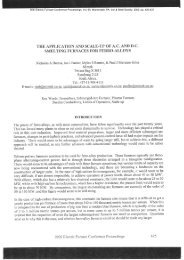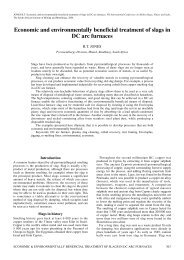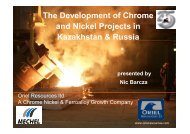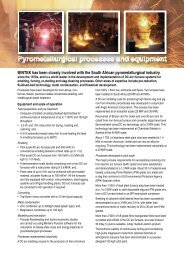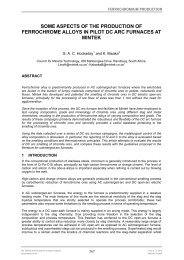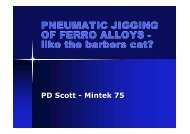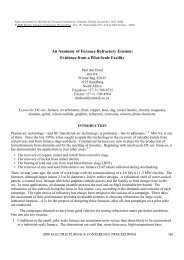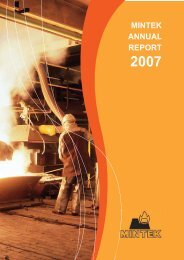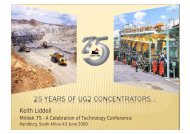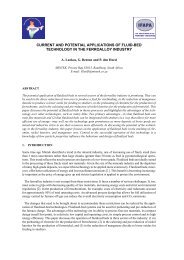Some myths about DC arc furnaces - Mintek
Some myths about DC arc furnaces - Mintek
Some myths about DC arc furnaces - Mintek
You also want an ePaper? Increase the reach of your titles
YUMPU automatically turns print PDFs into web optimized ePapers that Google loves.
<strong>Some</strong> <strong>myths</strong> <strong>about</strong> <strong>DC</strong> <strong>arc</strong> <strong>furnaces</strong>Significant commercialization of <strong>DC</strong> furnace technologyoccurred in the 1990s, when there was a huge demand for <strong>DC</strong><strong>arc</strong> <strong>furnaces</strong> for steel scrap melting, following thedevelopment of high-power solid-state rectifiers. Around thattime, <strong>about</strong> 80 <strong>DC</strong> <strong>arc</strong> <strong>furnaces</strong> were built in the northernhemisphere. Apart from extensive use in the steel industry, itis only in the past few decades that <strong>DC</strong> <strong>arc</strong> <strong>furnaces</strong> havebeen used for smelting processes, where the feed materialsare predominantly nonmetallic and significant chemicalreactions are involved. <strong>Mintek</strong>’s Pyrometallurgy Division hasbeen fortunate enough to be involved in the industrial-scalecommercialization of roughly one application of thistechnology per decade, and has become well known internationallyfor its work on <strong>DC</strong> <strong>arc</strong> <strong>furnaces</strong>2. This started withthe smelting of chromite ore fines to produce ferrochromiumin the 1980s, and was followed by the smelting of ilmenite toproduce titania slag and pig iron in the 1990s. In both ofthese cases, the process chemistry was well known and theproducts were familiar (albeit with some minor variations),even though the type of furnace was novel at the time. Afurther example was the use of a <strong>DC</strong> <strong>arc</strong> furnace to recovermetals (principally cobalt) from nonferrous smelting slags3,4early in the 2000s. In this case, a new process was carriedout in a ‘new’ piece of equipment to produce a somewhatunfamiliar intermediate product. This, therefore, requiredtesting and demonstration at quite a large scale. There arecurrently another two applications of <strong>DC</strong> <strong>arc</strong> furnacetechnology that are poised on the brink of commercialization—namelythe smelting of nickel laterite to produceferronickel, and the ConRoast process5, which can be used forthe smelting of both platinum group metal (PGM) and nickelsulphide ore concentrates.Myth 2: <strong>DC</strong> <strong>arc</strong> <strong>furnaces</strong> need a hollow electrode andstabilizing gasThe first conceptual <strong>DC</strong> <strong>arc</strong> furnace for smelting applications6envisaged a hollow graphite electrode as a feed chute to placethe feed material in the highest temperature zone of the slagsurface. In the early 1980s, <strong>Mintek</strong> interacted with ASEA inSweden and Lurgi in Germany regarding the ELRED processfor ironmaking. The ELRED process was based on a hollowgraphite electrode and this approach offered much greaterscale-up potential than the proposed water-cooled plasmatorches at that time. In 1985, the first commercial <strong>DC</strong> <strong>arc</strong>smelting furnace treating chromite fines used the hollowgraphite electrode feeding arrangement, as did all subsequent<strong>DC</strong> <strong>arc</strong> smelting <strong>furnaces</strong> built over the next 15 years. It iswidely thought that by feeding through the hollow electrode,the feed materials will also pass through the plasma makingup the <strong>arc</strong> column and thereby be exposed directly to the hightemperatures typical of these plasmas i.e. > 10 000 K. As ithas been shown that the <strong>arc</strong> attaches to the electrode in ahigh-intensity spot (~3.5 kA/cm2)7 that moves rapidly overthe relatively large surface of the graphite electrode tip (thecathode) as well as over the surface of the molten slagsurface (the anode), to maintain the lowest resistance path, itis probable that the <strong>arc</strong> column will move away from therelatively cold and high-resistance feed materials. The highvelocity and viscosity of the gas in the <strong>arc</strong> column make itdifficult for solid particles to become entrained into the <strong>arc</strong>column. Plasma spraying and coating applications usuallyuse a water-cooled plasma torch arrangement whereby thesolid particles are injected through the torch assembly intothe region close to the <strong>arc</strong> attachment spot so that theMaecker8 effect can entrain them into the <strong>arc</strong> column. It isalso often assumed that a hollow graphite electrode feedarrangement is essential to avoid large losses of entrainedfinely sized feed materials to the gas stream leaving thefurnace through the off-gas port.However, it was clear that it would be advantageous toavoid the additional manufacturing cost of a hollow electrodeas well as the additional complexity of attaching the feedchute to the top of the electrode column, including provisionof an inert gas (usually nitrogen). This gas was required toprevent hot furnace gases from entering the feed system andwas also thought to improve the stability of the <strong>arc</strong> itself.Consequently, in 1996, <strong>Mintek</strong> investigated the effects offeeding bag-plant dust through a hollow graphite electrodecompared with feeding it through ports in the roof. Theseports were located less than 500 mm from the centre of the200 mm solid graphite electrode. It was found that, even withthese very finely sized materials (100% < 20 µm), there wereno significant metallurgical differences in smelting behaviour,and the percentage of feed materials reporting to the furnacegas-cleaning plant increased only from 4% to 7%.Subsequent experiments with larger-sized feed materialssuch as chromite (D 50 of 0.5 mm) showed an increase in dustlosses of less than 1% of the feed material. No negative effectwas noticed on the stability of the <strong>arc</strong>, despite the absence ofthe nitrogen gas down the electrode.The first commercial <strong>DC</strong> <strong>arc</strong> smelting furnace to utilizesolid graphite electrodes and roof feed ports was the 40 MWfurnace at Chambishi Metals3,4 in Zambia in 2001, based onthe <strong>Mintek</strong> pilot-plant testwork with this arrangement(known as side-feeding). Subsequently, some of the <strong>DC</strong><strong>furnaces</strong> originally installed with hollow graphite electrodefeed systems have adopted side feeding, and this trend isexpected to continue.Myth 3: The <strong>arc</strong> is a steady cylindrical column of hotgasA commonly held view is that the <strong>arc</strong> inside a <strong>DC</strong> plasma <strong>arc</strong>furnace is a steady-state phenomenon. In literature on thesubject, the <strong>arc</strong> column is often shown as having acylindrical, symmetric shape and taking the shortest pathbetween the end of the electrode and the surface of themolten bath beneath. Many of the mathematical andnumerical modelling methods used to study plasma <strong>arc</strong>s alsopromulgate this impression by discarding the time-dependentterms in the governing equations, and using cylindricalcoordinate systems which impose symmetry on the system.Recent work in this area7 has shown that plasma <strong>arc</strong>models developed using explicit time dependence andCartesian coordinate systems are able to display a wide rangeof dynamic motion and asymmetric behaviour, with the <strong>arc</strong>column becoming twisted and deformed into complicatedirregular shapes over very short time scales (milliseconds orless). <strong>Some</strong> examples of this are given in Figures 1 and 2,which show the temperature field (scale 2000–15 000 K) inthe model at various times. The <strong>arc</strong> length is 5 cm, and the<strong>arc</strong> current is 500 A. The time dependence of the temperaturefield in the model is shown in Figure 3.▲666 OCTOBER 2011 VOLUME 111 The Journal of The Southern African Institute of Mining and Metallurgy



